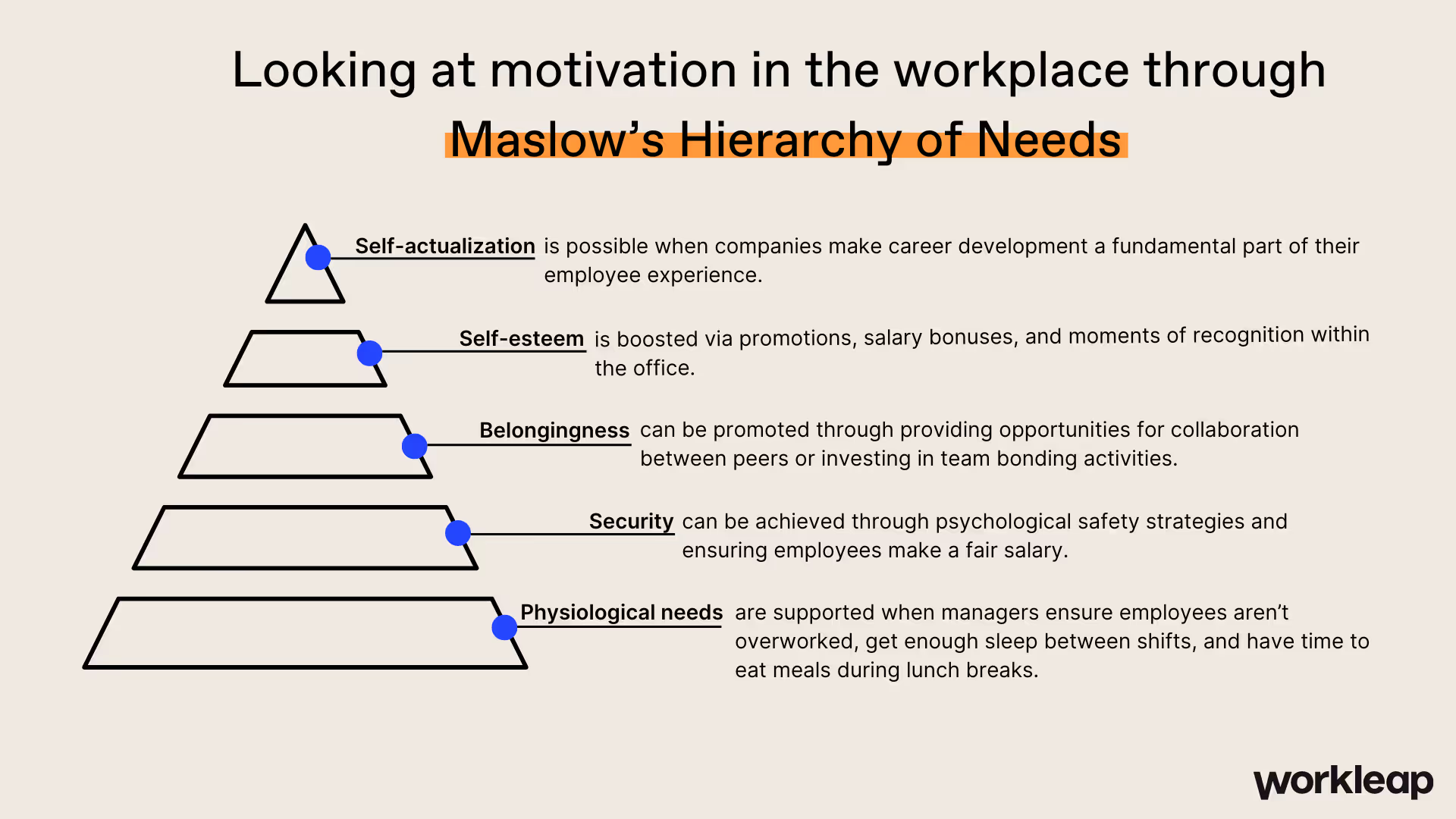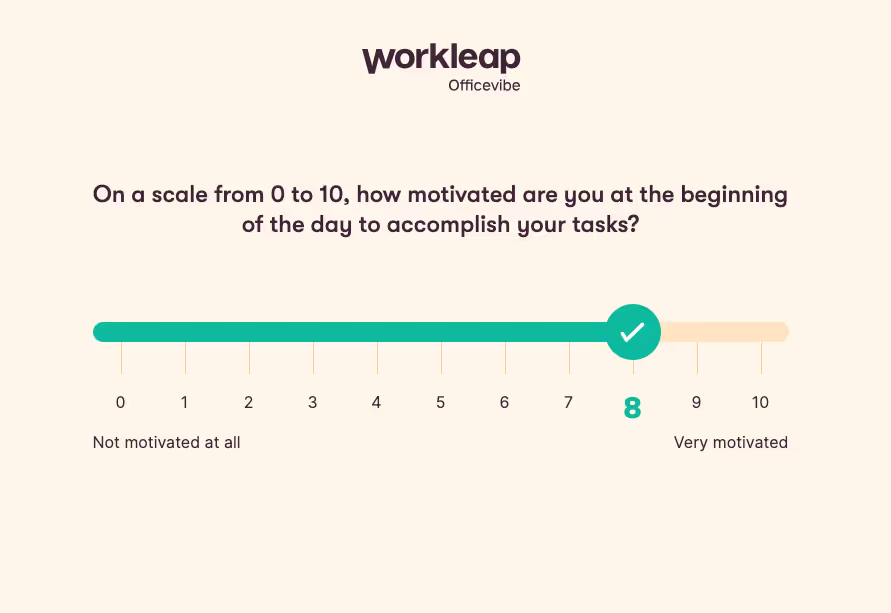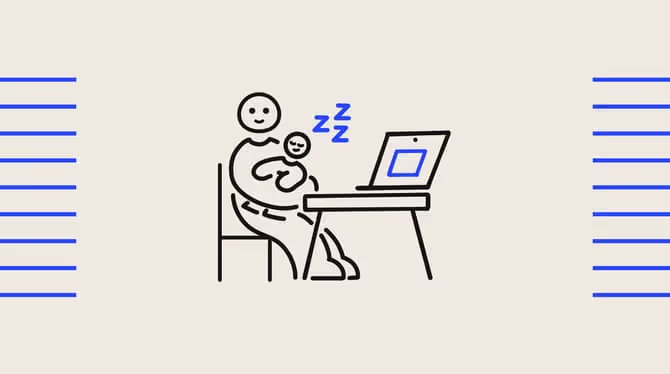Guide to performance motivation and its impact on the workplace

Discover Workleap Officevibe's benchmark report on 12 key employee engagement metrics

It’s the stuff that gets employees up in the morning, out of bed, and ready to tackle a new day at work. Motivation. But is that a given?
Talent may be hard to find, but keeping talent motivated is a challenge of its own. It's the modern-day manager dilemma: ensuring that your A-team isn’t just physically present at the office but also fully engaged and driven to excel.
Once managers get employees through the door and properly onboarded, the question becomes: How can they ensure a team’s sustained performance and long-term loyalty? How can we motivate our employees for lasting success?
This article covers it all!
What is performance motivation?
So, what's the buzz about performance motivation? It's not just about getting employees to punch in and out — it unlocks the door to their inner drive.
Motivation is the spark that turns a mundane task into a fired-up passion project. It's the energy that fuels an employee’s pursuit of excellence. Performance motivation is how managers engage with their teams to bring the best out of them, creating an environment where work becomes more than just a job.
But great performance motivation is achieved through more than just random pats on the back, yearly salary bumps, and free donuts on Fridays (although, who doesn’t love a free donut?). From creative motivation to social motivation, figuring out what exactly motivates your employees starts with having open conversations with them. That’s why feedback loops are so insightful — they give you a deeper understanding of each team member’s unique motivations triggers.
How employee motivation impacts organizational success
What does a motivated employee look like? They’re happy when they come to work, enjoy the challenges of their responsibilities, push through the hurdles, and engage with their colleagues. Their enthusiasm is contagious, influencing the collective mood and team productivity. They come in on time, are engaged throughout the day, and don’t look for any excuse to clock out early. A motivated employee genuinely appreciates their job. And their motivation has a positive ripple effect on the rest of their peers.
Now, picture an unmotivated employee. They might still perform — but likely only to do the bare minimum. It might take them two hours to do a 30-minute job because they don’t really take joy or pride in their tasks. They show up to work, but their energy might not be all that positive. They might even bring down and demotivate everyone else
As a manager, you want as many motivated employees as possible. It’s not just for the feel-good factor but also because a motivated workforce is a strategic advantage that can significantly impact your company’s bottom line. It's the difference between a team that meets expectations compared to one that exceeds them.
But don’t take our word for it — believe the numbers. According to Gallup, businesses with highly motivated employees are 21% more profitable.
There’s a real strategy for boosting employee motivation, and it comes alive through excellent performance management.
Performance motivation vs performance management: What’s the difference?
Performance motivation and performance management are very closely linked but not quite the same. See performance motivation as a core piece of the performance management puzzle.
Performance management is about the structure of performance — setting expectations, creating a plan and mapping out goals, providing feedback, evaluating results, and constantly upgrading the system to ensure everyone stays at the top of their game.
On the flip side, performance motivation is the soul of the operation — it taps into what makes employees tick, understanding their aspirations and aligning them with the organizational journey.
While management ensures tasks are done, motivation guarantees they are done with passion and purpose. All in all, performance motivation is the stuff that makes performance management great.
The science behind motivation and employee performance
If you’re a bit of a science buff, you’ll love this — performance motivation is deeply rooted in psychological and neurological processes.
Understanding the science behind motivation unveils the intricate mechanisms that impact employee efforts, persistence, and even choice of task. The better managers understand the psychological foundation of motivation, the better they can support their employees.
Motivation in the workplace can be tied to basic psychological needs identified by psychologists. Recall Maslow's Hierarchy of Needs, which suggests that individuals are motivated by the pursuit of fundamental needs like security, belongingness, and self-esteem. Helping employees meet these needs at work is the foundation for sustained employee motivation:
- Physiological needs are supported when managers ensure employees aren’t overworked, get enough sleep between shifts, and have time to eat meals during lunch breaks.
- Security can be achieved through psychological safety strategies and ensuring employees make a fair salary.
- Belongingness can be promoted through providing opportunities for collaboration between peers or investing in team bonding activities.
- Self-esteem is boosted via promotions, salary bonuses, and moments of recognition within the office.
- Self-actualization is possible when companies make career development a fundamental part of their employee experience.

The key is ensuring employees can meet their fundamental needs first (like physiological and security) before meeting needs higher up on the pyramid (like self-esteem and self-actualization). When 65% of Americans report living paycheck to paycheck, managers need to make sure a company’s priorities align with their employees’ for motivation tactics to have a lasting impact.
Understanding motivation from a neuroscience perspective
The brain plays a big role in motivation! It’s all about the chase of dopamine, which the brain’s reward system is mainly governed by. Rewards, both intrinsic (personal fulfillment) and extrinsic (monetary incentives), stimulate the brain's pleasure centers. These all reinforce behaviors associated with positive outcomes.
The more rewarding the experience of performing well is to an employee, the more motivated they will be to perform. That’s why it’s important for managers to create a system that encourages high performance through positive association rather than fear or punishment tactics.
Strategies to motivate employees to improve performance
Global surveys have revealed consistent drops in motivation among employees since 2020. This shows us a great opportunity to breathe enthusiasm back into our workforce!
So, let's get down to business. How do you motivate employees? The first thing is to be aware that different things motivate different people — so motivating for improved performance isn't a one-size-fits-all deal. Like with most performance management processes, the key is a tailored approach.
There are several motivation strategies you can apply to create the right formula for your team:
1. Setting clear goals
Ambiguity can be a motivation buzzkill, whereas clearly defined, achievable goals provide a roadmap for your team. Employees are much more confident and perform better when they know what they must do to succeed. Setting clear goals and regularly revisiting and revising them as needed keeps motivation levels high.
{emphasize}Let's say you're in a sales team. Instead of a vague target like "increase sales," a clear goal would be to "achieve a 20% increase in monthly sales for the next quarter." This specificity provides a roadmap for your team, making their efforts more focused and their success more measurable.{emphasize}
2. Creating a positive work environment
A positive work environment is the breeding ground for motivation. When employees feel comfortable, valued, and supported, they are more likely to be motivated to give their best at work. This also has a domino effect — motivation is contagious.
You want to create the kind of workplace where open communication is encouraged, teamwork is celebrated, and leaders actively foster a culture of respect and appreciation. This ensures employees are motivated not just by tasks but by the positive vibes that surround them, boosting morale and performance altogether.
Daily kudos for a job well done or weekly check-ins go a long way toward making employees feel valued. Inviting team members to share their ideas during meetings, setting aside time for open discussion, and integrating suggestions into company processes are ways to show everyone matters.
3. Providing opportunities for skill development
Motivation often stems from a sense of growth and progress. Providing opportunities for career development shows employees that their professional evolution and happiness matter. Over 65% of employees report they would stay at a company longer if their employer made efforts to invest in upskilling opportunities.
{emphasize}For an IT team, offering coding workshops or certifications could be a way to motivate your team members. It communicates that the company values their skill enhancement and is willing to invest in their long-term professional growth.{emphasize}
4. Being generous with recognition
Recognition is fuel for motivation. When employees know their efforts are seen, appreciated, and even rewarded, it creates a positive feedback loop that enhances motivation. Refer back to our earlier section on the hierarchy of needs — even a simple recognition like acknowledging a job well done during the next team meeting goes a long way.
Programs like a monthly "Employee of the Month" award or fun peer-to-peer recognition like Good Vibes are great ways to spark motivation throughout the year.
5. Empowering through autonomy
Empowering employees to make decisions and take ownership of their work fosters a sense of responsibility and autonomy. After all, it feels good to be entrusted with important tasks and to feel a supervisor has faith in your judgement, right? Autonomy can be a powerful motivator, and it doesn’t have to happen by accident.
{emphasize}Rather than micromanaging every campaign detail, for example, give your team members the autonomy to experiment with different strategies where possible and appropriate. This motivates them to showcase their skills and encourages innovation and creative thinking.{emphasize}
The best ways to measure employee motivation
While you can't slap a number on someone's enthusiasm, it’s definitely possible to measure motivation to an accurate degree. Look for signs of engagement, initiative, and resilience. Are employees volunteering for tasks? Are they bringing fresh ideas to the table? What are employees telling you?
Measuring motivation is complex but crucial to gage if your performance motivation strategies are working. Two main ways to collect insights are directly (surveys) and indirectly (performance metrics).
Go to the source: Leverage surveys and employee feedback
If you want to know how motivated employees are about specific tasks or at a certain point in time, go directly to the source. By regularly gathering feedback on job satisfaction and motivation levels, you can uncover more opportunities to fine-tune your management process. Surveys can also help you understand each employee’s perceptions of motivational factors and what best to capitalize on.
Employee surveys
Employee surveys are a direct window into the collective mindset of your team. By gathering feedback on various aspects of work, including motivation, you gain insights that can guide targeted improvements. Using anonymous surveys could be a great advantage, too, as employees feel more comfortable sharing the negatives when the fear of repercussions is removed.
Conducting quarterly surveys that include questions about motivation levels provides managers with valuable data. Asking employees to rate their motivation on a scale of 1-10 and allowing open-ended comments helps understand the factors influencing their motivation.

Quality of communication and response time
The quality of communication within a team and how quickly responses are addressed can indicate the work environment's health and its impact on motivation. Take note of your 1:1 conversations or passing comments by the water cooler. It’s incredible what employees can share with you about their motivation levels without even realizing it.If there's a suggestion box or a virtual platform for feedback, regularly reviewing and responding to suggestions or concerns sends the clear message that their inputs are valued. Being able to pick up on small details, like survey participation rates, is an essential management skill.
Look at hard data: Performance metrics reveal hidden truths
Analyzing performance metrics can help managers identify correlations with motivational factors. KPIs like productivity, engagement, and job satisfaction are telling over time.
Employee performance metrics
Performance metrics go beyond assessing output — they can also reflect an employee's level of engagement and motivation. Analyzing key performance indicator (KPIs) metrics provides a quantitative measure of motivation and reveals red flags.
Having a look at KPIs over time, like if sales targets are being met or projects are being completed on time, can show patterns. Consistent performance could indicate sustained motivation, but a decline might suggest a loss.
Attendance and punctuality
Attendance and punctuality can offer insights into employees' motivation and engagement levels. Demotivated employees don’t necessarily arrive on time or early for a job they aren’t excited about — consistent absenteeism or tardiness might indicate an underlying motivation issue.
If a usually punctual employee starts arriving late without an apparent reason, it could be beneficial to have a conversation to understand if there are motivational challenges, which might be external or internal. It’s always good to get to the bottom of these things and keep a close eye on improvement.
Employee turnover rates
High turnover rates might suggest a lack of motivation or job satisfaction among employees. Think about it — motivated employees want to stay in their jobs, not quit them. Tracking turnover can provide an indirect measure of motivation levels within the organization.
If a department experiences a sudden surge in resignations, it's crucial to investigate the reasons behind the trend. It could be related to unaddressed motivation issues. Addressing these can help regain a motivated workforce and, in return, improve retention.
Remember, measuring and increasing motivation is an ongoing process. Regular assessments and a commitment to fostering a positive work environment contribute to sustained motivation and, consequently, better job performance.
Keeping work motivation up: Why it’s everyone’s responsibility
Like any successful performance management strategy, work motivation for performance enhancement isn't a solo act. Cultivating a motivational ecosystem is a collective responsibility.
Organizations as a whole play a pivotal role in setting the stage for a motivated workforce. They are the structure that houses a culture that values employee well-being, provides growth opportunities, recognizes achievements, and sets the foundation for sustained motivation.
That said, managers greatly influence employee motivation, accounting for 70% of the variance in their team’s engagement and performance. But motivation isn’t just a top-down phenomenon, as motivation comes alive through individual employees. By taking ownership of their work, participating in setting the right goals, and actively seeking opportunities for growth, they contribute not only to a motivated mindset but also to a positive peer pressure effect. Remember — motivation is not just a task; it's a shared responsibility. Together, we create workplaces that inspire.
The Workleap solution: Using technology to increase work motivation
Employee performance motivation can be seen as both an indicator of performance and a driving force. It serves as a guide to gauge how well your management strategies are fairing and what needs to be adjusted to reach optimal levels across the team.
Keeping your eye on motivation levels is a day-to-day battle. But there are tools built to help you manage the ups and downs without breaking a sweat and keep your finger on the pulse. That's where Workleap’s Officevibe comes in.
Part of our many workplace solutions, Officevibe is a performance management software designed with both managers and employees in mind. From seamless goal-setting features to real-time feedback mechanisms, it’s a management tool designed to elevate motivation and, ultimately, job performance. Explore how Officevibe prioritizes performance engagement and motivation to enhance your workplace.
Give HR and managers the clarity, confidence, and connection to lead better every day.


%20(1).avif)


.avif)
.avif)








